The Quiet Man: A Classic with a Lot to Say
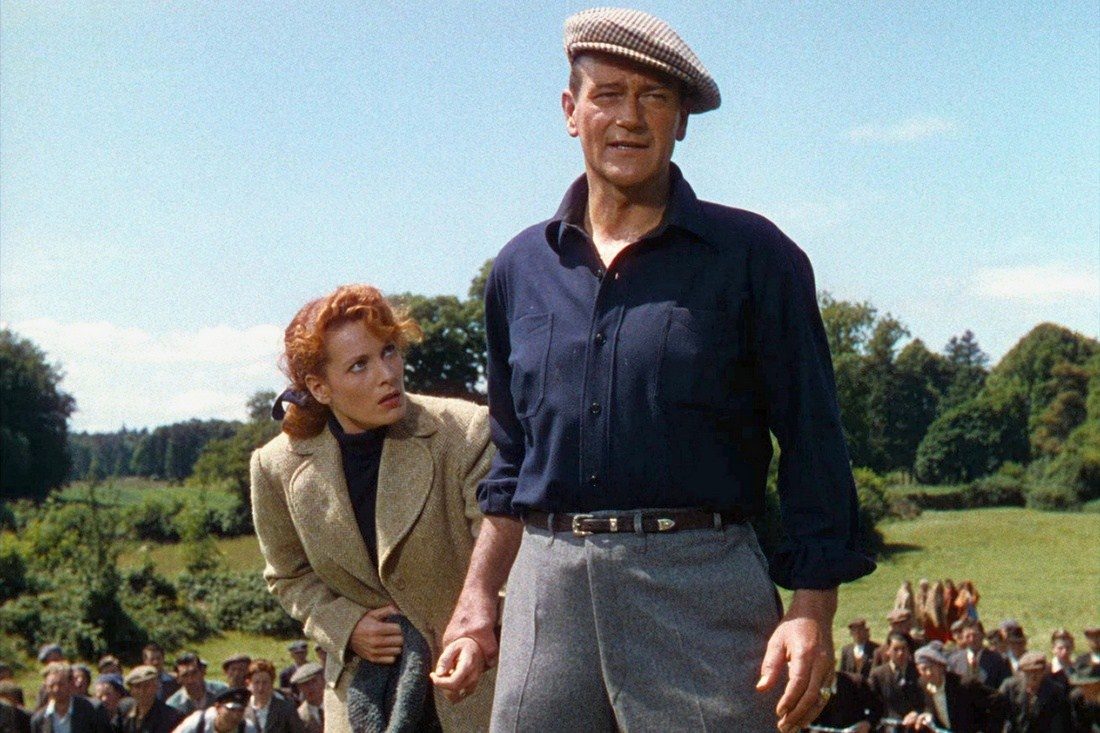
In a particularly famous scene in the classic John Ford film The Quiet Man (Republic Pictures, 1952), John Wayne drags his wife, Maureen O’Hara, across a field in Ireland. Wayne does this as he and O’Hara are pursued by an eager swarm of gawking villagers, such as one old woman who hands Wayne a tree branch and says “Here’s a good stick to beat the lady!”
The scene is devastating; it is lovely. Winton C. Hoch, who won the last of his three Oscars for cinematography for his work on The Quiet Man, had been frustrated by the lack of consistent sunlight during the first six weeks of location filming on the Emerald Isle. But on the day of filming the climactic sequence of Wayne dragging O’Hara back to their home to win his wife’s dowry, the weather held out for Hoch’s cameras. In the same scene, Ireland could scarcely be cast in a better or worse light, depending on how you view the film.
On the one hand, there are beautiful green meadows, glistening brooks, old stone bridges. On the other, toxic masculinity, dated gender stereotypes and the trivialization of domestic violence.
The stereotypes come fast and furious in The Quiet Man, beginning with the opening scene, in which Wayne’s character, an Irish-born American, arrives in the fictional village of Innisfree — “three hours late, as usual.” The implication that the town’s railroad service would be so incompetent as to routinely be hours behind schedule is typical of the dim view the film takes of the Irish. Men in the film are generally portrayed as lazy, mischievous sots (think: Barry Fitzgerald) and the women as ill-tempered gossips (Mildred Natwick).
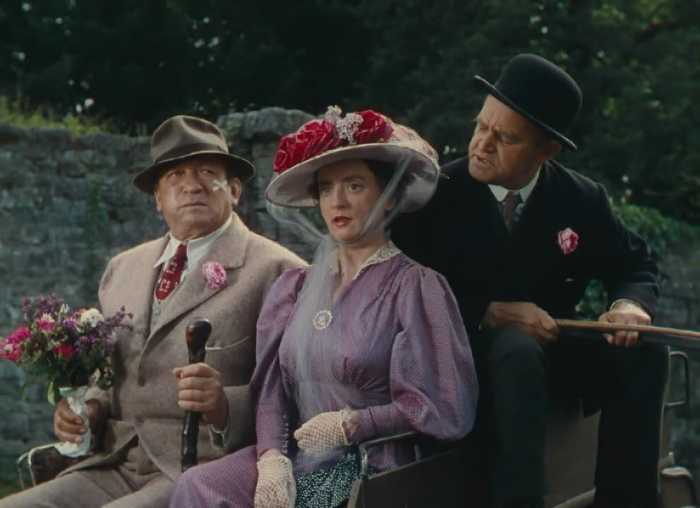
While riding out to his ancestral home, Wayne catches a glimpse of O’Hara herding sheep and falls immediately in love with her, though Barry Fitzgerald warns him of O’Hara’s infamous temper by saying “that red hair of hers is no lie.”
When O’Hara subsequently learns that Wayne is moving into the cottage her brother had intended to buy, she rushes off to clean the place for him. Wayne comes home in the middle of storm to find the floor swept and wood burning in the fireplace. He catches O’Hara trying to leave quietly, yanks her back violently and kisses her. She allows this momentarily, but then slaps him across the face. The following exchange of dialogue between their two characters is instructive:
MARY KATE (MAUREEN O’HARA): It’s a bold one you are. And who gave you leave to be kissing me?
SEAN (JOHN WAYNE): So you can talk?
MARY KATE: Yes. I can and I will. And it’s more than talk you’ll be getting if you take a step closer to me.
SEAN: Don’t worry. You’ve got a wallop.
MARY KATE: You’ll get over it, I’m thinking.
SEAN: Well, some things a man doesn’t get over so easy.
MARY KATE: Like what, supposing?
SEAN: Like the sight of a girl coming through the fields with the sun on her hair, kneeling in church with a face like a saint.
MARY KATE: Saint, indeed.
SEAN: And now coming to a man’s house to clean it for him.
MARY KATE: That was just my way of being a good Christian act.
SEAN: I know it was, Mary Kate Danaher. But it was nice of you.
MARY KATE: Oh. [Beaming] Not at all.
It’s a brief scene, but it offers a lot to unpack. We have O’Hara’s assertion of her independence, followed by her admission of Wayne’s physical advantage over her. And this is quickly followed by his implication that her femininity offers her its own advantages. In just a few lines of dialogue, the film’s casual acceptance of domestic violence is neatly encapsulated.
There is a longstanding tendency in Hollywood films to depict the Irish in a way that reinforces patriarchal views of the role of men and women in society. With the lockdowns associated with COVID-19 having caused a surge in cases of domestic violence in Ireland, a closer examination of the history, both ancient and recent, of gender dynamics in Irish culture may lead to a greater understanding as to how and why films like The Quiet Man capture the public’s imagination by perpetuating very particular gender stereotypes.
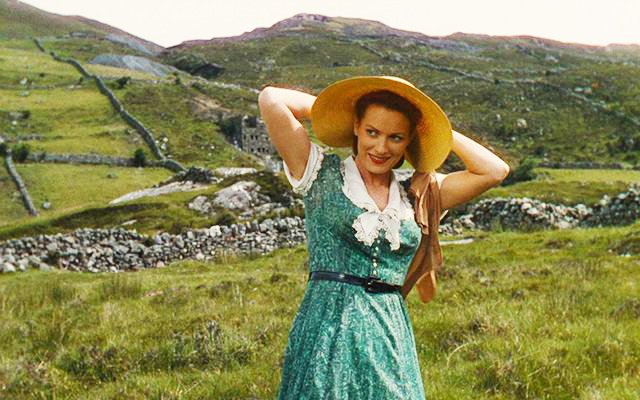
No one could mistake Maureen O’Hara’s character in The Quiet Man as weak in any way. Her assertion that she “can” and “will” talk calls to mind Mary Wollstonecraft’s A Vindication of the Rights of Women or Jane Eyre’s assertion that she is “a free human being with an independent will.” But violence has long had an implacable effect on the lives of Irish women living in both the Republic and Northern Ireland.
Though this violence was sustained for many years by The Troubles (Irish Republican women in the 1970s were known to have been tarred and feathered for associating with men from the other side in the independence movement), violence against women in Ireland has not been caused nor maintained by war alone. The Catholic Church perpetuates the hostile climate toward women through misogynistic doctrines that have tainted many aspects of Ireland’s politics, laws and culture for centuries.
In The Quiet Man, for example, when O’Hara seeks her parish priest’s advice during a rough patch in her marriage to John Wayne, the priest (Ward Bond) admonishes her for her “sinful” insolence to her husband. And when Wayne makes an offer for O’Hara’s hand in marriage, being in a foreign land he must abide by longstanding Catholic customs involving O’Hara’s dowry, and her loutish and overly powerful brother.
In the 1950s, on both sides of the Atlantic, domestic violence was also more tolerated than it is now. This was obviously bad for all involved, especially the women. As late as 1964, one study cited in a Time magazine article concluded that spouses stay in abusive relationships because their fighting can “balance out each other’s mental quirks.”
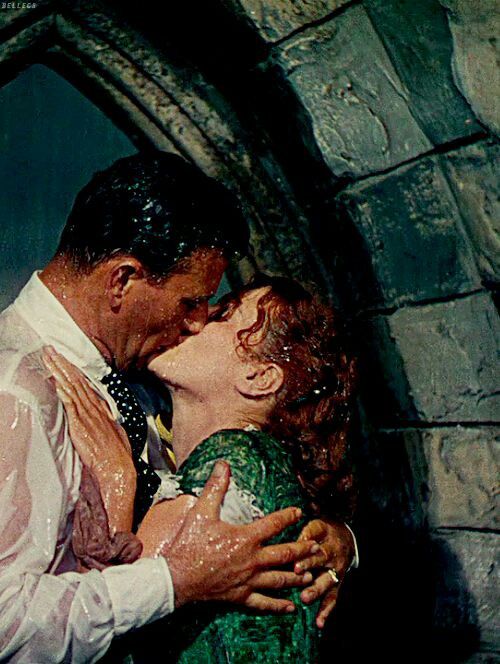
To be sure, the forced kiss John Wayne and Maureen O’Hara share in a rainstorm in The Quiet Man cements the notion that, as far as John Ford was concerned, women were there to be kissed. It’s a worldview that is no longer permissible on-screen, but it is interesting how frequently this casually sexualized violence has been shot in such a romantic way that it signals a consensual relationship to the audience. The Quiet Man is a far cry from the sadomasochism of Fifty Shades of Grey, but the films share a view that sex is about a struggle for power in relationships. That view of sex as a power struggle has permeated Irish society since the Romans began conquering Celtic tribes throughout Europe.
A Historical Perspective: Women in Celtic Ireland
I am the womb: of every holt,
— from Song of Amergin
I am the blaze: on every hill,
I am the queen: of every hive,
I am the shield: on every head,
I am the tomb: of every hope
A common perception of violence against women is that, historically, women have always lived in the shadows of violence. This concept of gender violence as an inherent part of the human condition provides both justification for violence against women as well as an excuse to allow the
issue to remain ignored. But the true origins of gender-based violence in Ireland can be more clearly defined by comparing the social and spiritual roles of women in Celtic tribes with those of modern Irish women.
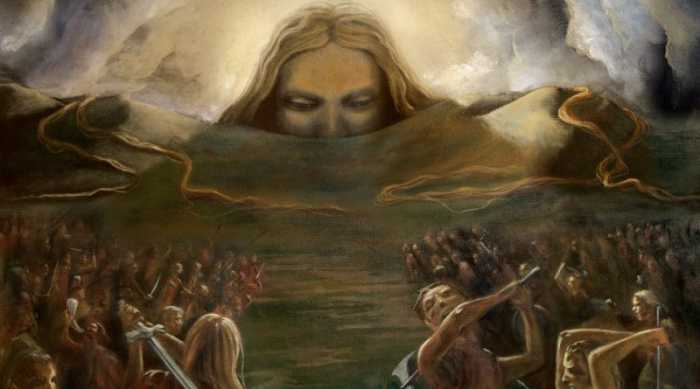
The Goidelic branch of Celts that settled in Ireland as early as the sixth century CE were matrilineal, and like all Celtic peoples, these tribes worshipped a mother-goddess. Their laws were based on decisions that were passed down by a woman who carried the namesake of the mother-goddess, Bridget. Consequently, the social and spiritual identity for both the Celtic man and woman at that time was feminine.
Though Celtic Ireland consisted of several small kingdoms that were ruled by kings, these kings were legitimized only by marriage to the mother-goddess. She was, by an extension of her function as Mother Earth,
the tribe and its territory. This influenced how women were treated within the tribes because each woman was symbolic of the goddess, especially the tribes’ priestesses who were revered by men as their spiritual link to the mother-goddess.
Though the structure of the tribes was similar to the patriarchal social and political structures in Ireland today, the matrilineal influence in each tribe made women equal on all social and private levels. The tribes’ social structure was divided into three classes: first, warriors, then the Druids, artists, and historians, and third, small farmers and minor craftsmen. Placement within these divisions was neither hereditary nor imposed on the basis of gender. Rulers were chosen according to their strength as leaders and divisions were based on talents and abilities. Women existed in all three divisions and fought with men in battle.
Gender Violence in Celtic Ireland
Although Rome never successfully conquered Ireland, Rome’s conquests with other Celtic branches throughout Europe probably influenced the traditions of Ireland’s Celtic tribes. The Romans, like the Greeks, restricted women, “to the production of offspring and the performance of household
duties.”
Yet, conquerors cannot oppress women or replace a matrilineal culture through war alone. Julius Caesar, who led the Roman wars against the Celts, meddled with Celtic history by omitting any references in his writings of the involvement of Celtic women in battles. Arguments against land ownership by women were justified by employing the tribes’ spiritual symbolism of “woman as land”; if she is the land then she cannot own the land.
The Romans also introduced rape as a means of controlling women, as it was an act often committed by Roman gods in ancient myths. Nowhere in Celtic mythology had a Celtic god raped or justified rape, so the feminine social and spiritual roots of the Goidelic tribes were, in that sense, distorted by exaggerating the patriarchal structures that existed within the tribes. The use of forced sex to control women continues to affect Irish society, and our perceptions of it in films like The Quiet Man.
Origins of The Quiet Man
The plot of The Quiet Man originated with a 1933 Saturday Evening Post story and 1936 novella by Maurice Walsh, both about an Irish prizefighter who returns to his hometown in Ireland and gets into a brouhaha over a dowry with his bride’s older brother. The story won over Ford, who, though he was born and bred in Maine, was endlessly nostalgic for Ireland, thanks to the tales he’d heard from his émigré parents. His pitches for The Quiet Man didn’t interest studios in the ’30s, when he wasn’t quite the Hollywood heavyweight he became and the subject seemed out of synch with a world reeling from the Great Depression and then World War II, and studios remained unconvinced about the project after the war, perhaps wary of portraying a hero abandoning America at a time when the Cold War was ascendant.
Which explains why Ford’s production of the film ended up at Republic Pictures, a poverty row outfit better known for bargain-basement Westerns than romantic comedy-dramas from Oscar-winners. Easy as it is to laugh at Republic’s typical output through the 1930s and 1940s, films with hokey titles like The Phantom Cowboy (1941) and Santa Fe Saddlemates (1948), some genuinely fascinating films had been released by the studio over the years, such as Orson Welles’ masterful adaptation of Macbeth or the noir-ish 1953 melodrama City That Never Sleeps, where character actor Chill Wills “plays” the City of Chicago.

Republic had experienced an uptick in quality when studio boss Herbert J. Yates decided that an occasional prestige production might raise the studio’s status and even turn a profit, provided filmmakers stuck to tight budgetary and scheduling parameters. Yates was very suspicious of The Quiet Man, though, which sounded to him like a European-type art movie, so he got Ford to make a Western with John Wayne — the star of some two dozen Republic Westerns already — before embarking on the Irish picture, also a Wayne vehicle.
Personally, I have more trouble with Ford’s treatment of Native Americans in The Searchers and She Wore a Yellow Ribbon than I do watching John Wayne toss Maureen O’Hara onto a bed in The Quiet Man. When Wayne drags O’Hara to the climactic confrontation and wedding that follows, it is worth keeping in mind that O’Hara has engineered all of this, motivated more by custom and tradition than by Wayne’s male dominance.
Adrian Frazer, in his book Hollywood Irish called O’Hara’s performance, which transcends the obvious cliché of the fiery redhead, a “revolutionary characterization of the Irish woman as a fully adult, pleasure-loving person.” But if O’Hara is a strong-willed, self-determined character, it is impossible to ignore the fact that the portrayal of gender in The Quiet Man, one of the top-grossing films of 1952, ultimately forces women into roles that are essentially subservient to men. O’Hara’s character in the film is named Mary Kate, a change from the original story, in a nod to The Taming of the Shrew.
Women in Modern Ireland
I am Ireland/and I’m silenced
— Máighréad Medbh, Easter 1991
I cannot tell my abortions/my divorces
my years of slavery/my fights for freedom
it’s got to the stage I can hardly remember
what I had to tell/and when I do
I speak in whispers
There have been many changes in Ireland in the last three decades, such as the Divorce Referendum that was passed in the spring of 1996 that gives abused women a legal window out of marriages that are literally killing them. In March of the same year, a Domestic Violence Law became effective that allows boards of health to apply for protection, barring, or safety orders on behalf of victims.
According to Irish Women’s Aid, there was a 41% year-over-year increase in the number of calls their national domestic violence hotline received between March and November 2020 versus the same period in 2019. So, though Irish women have gained ground legally, the number of domestic violence cases continues to escalate.

In her article, “Paying Our Disrespects to the ‘Bloody’ States Women Are In,” Ailbhe Smyth writes that the number of reported rapes “shot up from 76 in 1979, when the first rape crisis centre opened, to 1,479 in 1990, . . . in [a] twelve month period . . . Dublin police had to respond to a total of 3,500 cases of domestic violence.”
The church, state, and the laws of Ireland have all historically viewed women as the appendages of men, who share the same religious and political views by virtue of their gender alone. This assumption, and the refusal by government and religious leaders to question this assumption, maintains violence against women in Ireland. Due to the lack of knowledge regarding women’s issues on the part of government and church, much of the injustice suffered by Irish women remains unchallenged.
If that traditional Celtic view of women is little more than a fantasy that has no relation to the lived experiences of Irish women, then The Quiet Man is a fantasy all its own, one which has influenced the perception many people have of the Irish, and, according to John Ford biographer Ron Davis, boosted interest in Irish tourism. In The Quiet Man, Ford created a film in which the rigid conventions of the Church can be dismissed as playful quirks, the casual degradation of women a quaint and romantic act of chivalry. With its depiction of the lush Irish countryside, the appeal, perhaps, of a film like The Quiet Man is its utter lack of complexity. It is certainly not a film that requires its audience to think, and for all its faults and reliance of stereotypes it is fun to look at and certainly not without its simple pleasures. It is easy enough to understand why the film is the favourite St. Patrick’s Day rom-com for so many, and it has created a blueprint for virtually every Irish-set movie in the last seventy years.
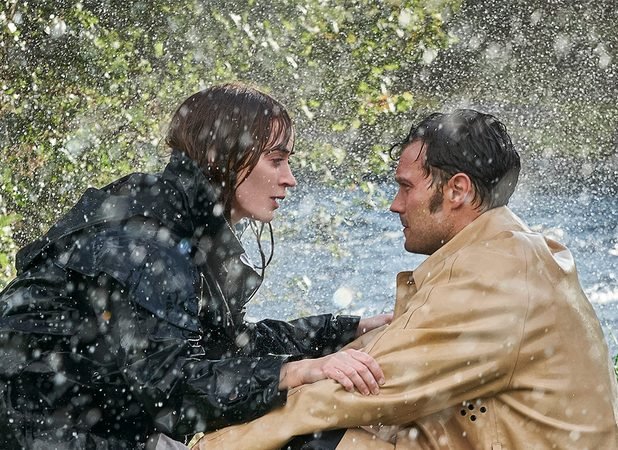
Ireland’s matrilineal Celtic culture was not replaced, as much as it was overshadowed by a patriarchy that distorted the image of woman and used her strengths against, rather than for, her. Men are abusing and killing women today because they can. Irish women have insufficient spiritual significance within the current religious dogma that still influences Ireland’s political and legal systems, and Irish men often lack the social and spiritual connections to women that existed in Celtic society. And Ireland does not yet seem to have a spiritual impetus to address the current trends of gender violence in a more significant, systemic manner. Ireland has lost its identity with a mother-goddess, forcing Irish women to struggle for centuries to establish their own identities within a hostile culture. The problem is, it’s killing them.
What do you think? Leave a comment.











The strangest coincidence. I was on holiday in Mayo last month and visited Cong (where the vast majority of filming took place) for the first time and was completely transfixed by it and nearby Ashford Castle – where they filmed many of the scenes in the grounds of the estate. I hadn’t seen ‘The Quiet Man’ in years and put a wishlist item on my cable box, not expecting to see it anytime soon. Flicking through the channels this afternoon I was delighted and surprised to see it there and recording. Caught it just in time to see the famous village brawl and Sean Thornton burning the dowry money.
I love this movie. My favorite part was when The Duke and Daneher were fighting and they stop to go into the pub to have a pint. Erin go bragh!
The acting of John Wayne is so bad, but my Mom loves this movie. It was a different era, but I really don’t know how people could stand his exaggerated macho bullcrap after about the 5th viewing (of ANY of Wayne’s films). John Wayne makes Burt Reynolds’ acting look “nuanced”. OMG.
I first saw The Quiet Man as a child when it was released. It is still as wonderful today as it was then.
I saw the film and I visited in person the village where it was made. I love it because it truly has the spirit of the Irish in it. It really is not an exaggeration!
That is one place I would love to visit. I have been to a few places in Ireland, north and south. I truly love the place, I have friends in Belfast and we went for a day out to Bangor about eight years ago, a great day too.
I ordered this movie from Amazon and my wife and I pull this out at least a couple of times a year to really see what acting was in the day, not the CG twaddle that’s offered as entertainment these days. A true historical monument to acting and of course, the gorgeous backdrop of the Emerald Isle. Outstanding work by so many great actors of the day. Love Ward Bond as the “ frustrated fly fisherman” and of course, Barry Fitzgerald as the “ matchmaker/chaperone/cabbie. Just a warm, touching film.
John Wayne and Maureen O’Hara genuinely got along in real life. I believe they were in about a dozen films together, with The Quiet Man being one of the first if not the first (and one of the only non-Western, non-Military films). It also seems that they liked Shakespeare’s Taming of the Shrew as literary/theatrical influence: McLintock! was an entire retelling of The Taming of the Shrew (and another film where O’Hara starred opposite of Wayne).
Towards the end of the movie when Wayne and McLaglen are having their donnybrook, a young priest is reading something to a man on his deathbed. What was the passage he was reading from?
It should be remade, in all honesty, its a bit dated.
I love the scene when he dragged her off the train and back to her brother’s house. The old woman who hands John Wayne a stick and says, “Son here’s a good stick to beat the lovely lady with.” Back then you were allowed to beat your wife with a stick wasn’t thicker than your thumb!
I remember when I was a kid in school. I had a teacher that realized that I was a visual learner. So when the class was having to read ” The Quiet Man ” she made me watch it. Then do my written report on the subject. I loved it from the first time I saw it. I have watched it many many times now. But still won’t forget that first time. What a movie.
Learning styles are a myth.
This was one of my favorite movies of all time and even as a little kid I absolutely loved it. Thanks for the coverage, great analysis.
12 years after this movie was made, John Wayne contracted and beat lung cancer. His left lung was surgically removed. He kept making movies, so in some of his most popular films, the man is doing most of his own stunts with a single lung.
John Wayne may also be the only American actor ever targeted for assassination by Stalin. Wayne and his friends actually caught the KGB agents tailing him in a covert operation planned by Yakima Canutt.
Wayne died of stomach cancer, which is one of the most painful forms of death known to medical science. But before he called it quits, he wore a wet suit to add bulk to his horribly skinny frame eaten away by the cancer, put his tux on over it, and delivered a speech at the Academy Awards.
John Wayne is a true America bad-ass. They didn’t come any tougher than Wayne.
The best line by far in the movie is from Barry Fitzgerald….
“When I drink whiskey – I drink whisky ………….and when I drink water I drink water”
My favorite line and life motto haha
Thank you for pointing out that “it is worth keeping in mind that O’Hara has engineered all of this, motivated more by custom and tradition than by Wayne’s male dominance”. Sean had told Mary Kate that she did not need to collect her dowry from her brother but she insisted. I could argue that Sean dragging Mary Kate across the county is an acceptance on his part of a matter even though he disagrees with it. She accepts the dowry from her grudging brother. Sean ceremonially opens the door of the stove and Mary Kate ceremonially throws the cash into it… signifying her acceptance of Sean’s argument that she does not need the money.
One of best films ever made and can be watched over and over it is so entertaining.
My favorite John Wayne and Maureen O’Hara movie. They starred in several westerns, all of which I have, and they made a fantastic screen couple… there was chemistry between them on the screen and they both knew it. So did the audience. Great movie, great actors and actresses, unforgettable.
First movie in a cinema was the quite man, when you fall in love with a woman at eight years old you never quite fall out of it.
When I was about 10 -I was getting bullied and getting into fights because of my red hair. At the time I felt like an ugly duckling, until my Dad sat me down and put The Quiet Man on. He told me I could be that beautiful,feisty,strong person – Maureen O’Hara will always be beautiful in Ford’s film – thank you for showing timid redheads who we really can be.
One of my mother’s favorite films. One of my fondest memories was getting the VHS copy for my mother one christmas during the 90’s and she loved it.
Director George A. Romero was listening to the soundtrack of The Quiet Man when he passed away under hospice care. I think it was his favorite movie.
If you love this film then also see “Brooklyn”!
It appals me that anyone can find a film that sees such blatant abuse of a woman worth anything other than a mention in a museum. Coupled with the fact that the abuser was a racist and a homophobe in real life really does question the nostalgia people see in this drivel – unless, of course, you yearn for the days of yore and can recognise these attributes of the character in yourself.
Beautiful Ireland scenery, love story and phenomenal acting.
It was amazing to see the town for myself when I was in Ireland about 5 years ago. I did the whole dress up in costume thing they do when you take the tour of some of the movie sites and hear tales of how the locals reacted. Ashford castle is about 2 miles down the road where Maureen and John Wayne stayed during filming. I was told they had to send some of the crew down to a local pub to keep an eye on the Duke and make sure he made it back to his room at night.
I haven’t seen this film, in fact, I hadn’t even heard of it until recently. From what I have read though, including from your article, it is easy to see why many people now take issue with certain aspects of this film.
Great writing, by the way.
Captures Ireland before the modernization!
I used to like John Wayne until I watched a biography on him. He was definitely one of those actors/people who fit in to that period.
This was such a great movie.
I genuinely appreciate the delve into not only the societal, but cultural implications that come with this film. As a fan of old movies (including this one) its difficult to watch them and divorce yourself from modern awareness. We can get caught up in the romantization of the presentation and miss the underlying problems. Similar can be said of the cultural stereotypes rampant in films that are often played for laughs, mainly than anyone “foreign” is shifty and untrustworthy, but in presentation of the actual culture and complex identity it’ll be interesting to see the narratives of representation be widened.
I was born in 1953 just a 100 miles from were the movie was made and I’ve been back many times.
Great film, great actors, great scenery. Barry Fitzgerald was amazing.
Wonderful film. Must be one of Ford’s greatest. It makes me laugh and emotional too as I have Irish on my mother’s side. Wayne is great as usual as are Fitzgerald, McLaglen, Bond etc but Maureen O’Hara is just stunning and Ford makes the most of her beauty and personality.
Never saw notin like this film lovely pice of irish history.
Old is Gold.
I always remember watching The Quiet Man as a kid on channel 9 WOR every St. Patrick’s Day with my family. It was great. Classic.
One of my favorite movie by John Wayne. Who is well known for action movies. But, this movie show how a strong man can also be gentle and tender hearted.
A good essay about a movie that is uncomfortable but entertaining to watch. I’m sure when it first was released it was not seen the way you discussed it in your essay.
I find it interesting that this essay claims the rainstorm kiss was “forced.” I guess it’s all in the eye of the beholder, but I’ve never read it like a power struggle or like Sean is subduing her. (Unless the author is referring to the acting between Wayne and O’Hara, in which case I still respectfully disagree.)
What always strikes me about this scene is its overwhelming tenderness. Sean and Mary Kate are both just such prideful, stubborn individuals, and when they finally let their guards down with one another, the results are almost soberingly intimate. You see in their eyes how the companionship they find with each other seems to them both soothing and frightening.
It’s one of those rare moments were we see a paragon of masculinity like John Wayne look truly vulnerable.
Watching this movie from the vantage point of 2021, I can see how far we’ve come from 1952 standards, both in the way women were treated then and the rather childish ways men behaved in general. (Today’s actors are so much better, as are the scripts.) This movie might be okay cinematically, but it depicts the Irish in a demeaning way, as a stereotype.
The film almost takes place in a fantasy land, or as you put it, in Ford’s emerald-tinted imagining of Ireland. What really is imagined is a beautiful land through which a violent man can stride proudly and claim anything as his own.
For me, it showed me a great deal about the American hero. When the conflict is stripped away and the guns put down, that really all John Wayne was portraying was a brutish bully. O’Hara’s performance is very memorable, and is a testament to her acting abilities, but you’re right. The context of women’s treatment in Ireland causes any positive feelings about the film to shrivel into nothing.
I recently watched The Quiet Man for the first time, and while I wanted so dearly to love it, I struggled. I am usually not averse to the treatment of women in classic cinema, and admittedly, I am no diehard feminist (in spite of my womanhood): the inequalities depicted to that end are a product of the times, and I have no issue with men and women having different roles. However, I was genuinely put off by Sean’s utter disrespect for Mary Kate, to the point that I had a difficult time even crediting this as a rom-com, as I felt very little romance in the film whatsoever. I love your connection to the traditional Irish matrilineal structure – perhaps this is why the treatment of Mary Kate sat so uneasily with me. The characters with the plot had such promise, but Mary Kate felt terribly stifled and thus a bit confusing – she was a ‘fiery redhead’ one moment and uncharacteristically subservient the next, depending, so it seemed, on romantic convenience.
Anyway, you touched on many of the structural points I struggled with upon my first introduction to this movie – the inconsistencies, the misplaced idealizations, the incorrect fantasy of Irish culture – and even as a fan of classic cinema, I felt this one could not be accepted so simply as many of the others I’ve seen from the same era. It has a lot to say, and I think you have handled that fact brilliantly.
I find their relationship toxic on both ends. They don’t respect each other enough, they argue too much & fight like siblings. If you can’t get along like bestest best friends, don’t marry at all, because romance deteriorates quickly in just a couple of years. & this is despite knowing that the two actors were very close friends. Other issues I have with the movie are overuse of the same background music & blurry low quality greenscreen not blending in at all with the actual beautiful scenery.
This film takes place not in the 1950s but in the early 1930s, the time the original story was written. This is not stated in the movie but is obvious from the costumes and the fact that there are almost no cars in the village.